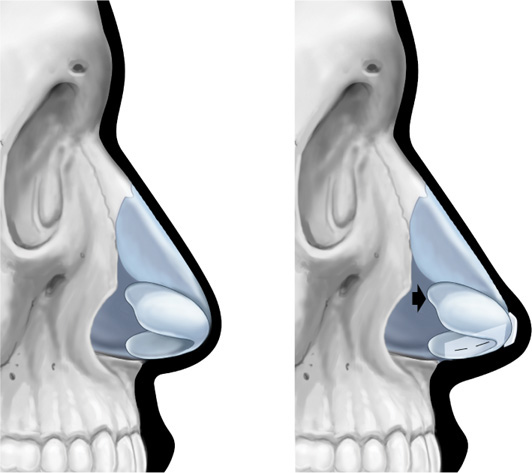Chapter 19. Increasing Tip Projection
 Indications: Patients who lack nasal tip projection may be candidates for techniques that increase tip projection via the placement of sutures or grafts into the nasal tip structures (Figure 19-1). It should be noted that inadequate tip projection cannot be improved simply by reducing the dorsum. A true lateral photograph will better elucidate the need to increase tip projection.
Indications: Patients who lack nasal tip projection may be candidates for techniques that increase tip projection via the placement of sutures or grafts into the nasal tip structures (Figure 19-1). It should be noted that inadequate tip projection cannot be improved simply by reducing the dorsum. A true lateral photograph will better elucidate the need to increase tip projection.
Figure 19-1. Underprojected nasal tip and its subsequent correction.
 Markings: No specific skin markings need to be made preoperatively. However, a well-thought-out plan for surgery should be created including a tiered approach to achieve the desired result.
Markings: No specific skin markings need to be made preoperatively. However, a well-thought-out plan for surgery should be created including a tiered approach to achieve the desired result.
 Approach: The nasal tip may be approached via an endonasal or open nasal approach.
Approach: The nasal tip may be approached via an endonasal or open nasal approach.
 With the endonasal approach, bilateral intercartilaginous and infracartilaginous incisions are performed to allow the lower lateral cartilages to be freed from the skin of the overlying nasal tip. As two bipedicle flaps, they are then reflected outside the envelope of the nasal tip skin to be better visualized and manipulated. Sutures may be placed within each lower lateral cartilage or passed from one lower lateral cartilage to the other.
With the endonasal approach, bilateral intercartilaginous and infracartilaginous incisions are performed to allow the lower lateral cartilages to be freed from the skin of the overlying nasal tip. As two bipedicle flaps, they are then reflected outside the envelope of the nasal tip skin to be better visualized and manipulated. Sutures may be placed within each lower lateral cartilage or passed from one lower lateral cartilage to the other.
 With the open nasal approach, a standard incision is made across the columella, extended up either side, and continued caudal to the inferior margins of the lower lateral cartilages. The nasal tip is dissected out as previously described.
With the open nasal approach, a standard incision is made across the columella, extended up either side, and continued caudal to the inferior margins of the lower lateral cartilages. The nasal tip is dissected out as previously described.
 Techniques: A graduated method of achieving increased tip projection is recommended and progresses from sutures to struts and grafts.1,2
Techniques: A graduated method of achieving increased tip projection is recommended and progresses from sutures to struts and grafts.1,2
 Tip sutures: The simplest means of increasing tip projection is removal of any intervening interdomal tissue and suturing the middle crura to one another with medial crural sutures. Further projection can be achieved with interdomal or intradomal sutures. The lower lateral cartilage complex can also be elevated and sutured to either the septum or an anterior septal extension graft.
Tip sutures: The simplest means of increasing tip projection is removal of any intervening interdomal tissue and suturing the middle crura to one another with medial crural sutures. Further projection can be achieved with interdomal or intradomal sutures. The lower lateral cartilage complex can also be elevated and sutured to either the septum or an anterior septal extension graft.
Stay updated, free articles. Join our Telegram channel

Full access? Get Clinical Tree



